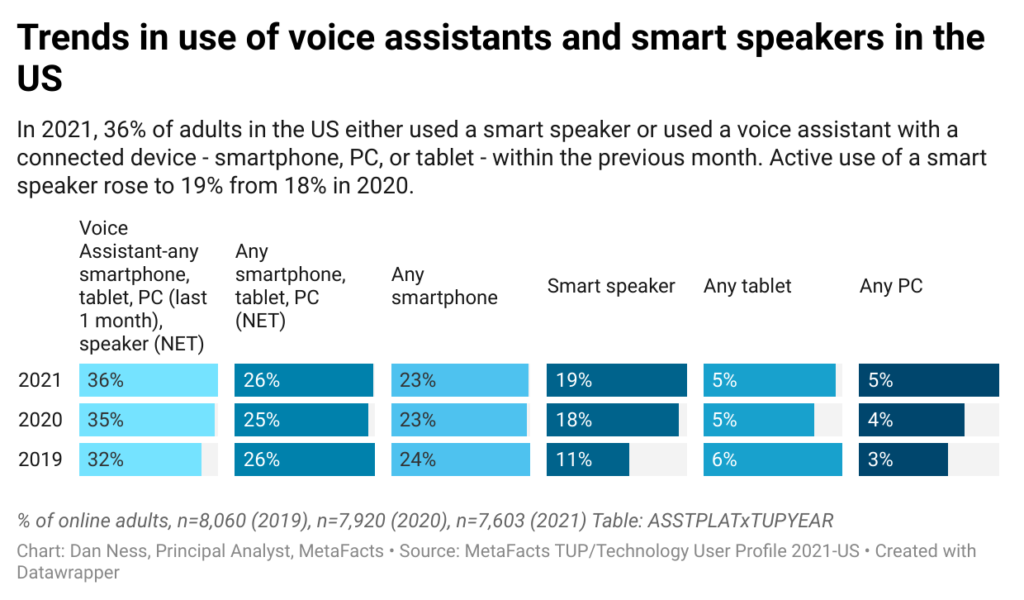Playing games with connected devices is widespread among American adults, while only a subset use game-focused equipment such as gaming PCs, gaming consoles, or VR headsets. This TUPdate reports on the share of adults regularly playing immersive/video or other games using their smartphones, PCs, or tablets, comparing them to the adoption rates of game-focused equipment.
Smart speakers among young and old
How deeply have smart speakers penetrated technology users’ lives? From 2019 to 2021, has market penetration shifted very much? Which age group has adopted smart speakers more quickly and deeply than others? How different is this in the US than in the UK or Germany or Japan? This TUP analysis reports on the percentage of online adults that actively use a smart speaker.
Online banking among socioeconomic groups
Using smartphones, PCs, or other connected devices for online banking is widespread, but not ubiquitous. Fewer American adults with lower income or less educational attainment use online banking than those with higher income or technically savvy. This MetaFAQs reports on the active usage of online banking among socioeconomically disadvantaged and advantaged groups, each defined by a combination of household income, educational attainment, homeownership, ethnicity, age, employment status, racial/ethnic identity, and other factors.
Breadth of voice assistant usage
Dan Ness, Principal Analyst, MetaFacts, December 13, 2021
Actively using a voice assistant or smart speaker
- This analysis focuses on those people who are actively using a voice assistant or smart speaker
- Have used a connected device to use a voice assistant within the previous month
- Smartphone, PC, or tablet
- Have a smart speaker
- Have used a connected device to use a voice assistant within the previous month
- Base: all online adults
Active voice assistant usage by platform – US
- The overall use of a voice assistant or smart speaker has only slightly increased between 2019 and 2021
- Smart speaker usage has grown the most among American online adults, rising from 11% in 2019 to 19% in 2021
- Voice assistant usage with other connected devices has not changed markedly
- Voice assistant usage with a smartphone continues to outpace smart speaker use

On-device video and movie watching among socioeconomic groups
Smartphones, tablets, and PCs are increasingly used to watch movies and videos. However, it is a regressive activity, being done more often among socioeconomically disadvantaged than advantaged groups. This MetaFAQs reports on the share of Americans regularly using their connected devices to watch movies and videos both before the pandemic (TUP 2019) and through 2021. The groups being reported consider age group, employment status, household size, ethnicity, presence of children, educational attainment, and other socioeconomic factors.
VR headset adoption
VR headsets are slowly and unsteadily working their way onto the heads of online adults. This TUPdate shows how penetration has expanded (and contracted) since 2018. By reviewing the activities that VR headset users do with their other connected devices – smartphones, PCs, tablets, or game consoles – this TUPdate profiles just who these VR headset early adopters are. Their creative, fun, collaborative, and educational activities point the way to possible hotspots of VR headset adoption.
Technology of single American parents
During the pandemic, parents without a spouse or partner have faced extra stresses, as they deal with school closures, childcare being less available, and other similar challenges. This TUPdate investigates this socially disadvantaged group to report on their current use of technology products and services – penetration by device type, hours of usage, number of devices, and work-from-home status.
Paid streaming music listening among socioeconomic groups
Listening to paid streaming music grew markedly among Americans, rising from 29% of online Americans in 2019 prior to the pandemic and reaching 36% in 2021. This MetaFAQs reports on the percentage of Americans regularly using their connected devices for paid streaming music by socioeconomic group. The groups being reported consider age group, employment status, household size, ethnicity, presence of children, educational attainment, and other socioeconomic factors.
Technology use among American IT employees
Do American IT employees lead the way in technology, at least with the tech products and services they use? This TUPdate reports on this socioeconomically and technologically advantaged group, contrasting them with the disadvantaged. The TUP results identify the penetration of device form factors within this group and other groups, as well as the number of connected devices they use, the hours they use them, and their work from home status. This TUPdate also identifies the activities this group does with their devices that is uniquely different from other advantaged, disadvantaged, and average Americans, as well as their active collection of consumer electronics and purchase plans.
Fun and games-devices versus consoles
Fun is a core activity drawing many people to use and enjoy their connected devices. While game consoles get a lot of focused attention, a substantially larger number of people regularly play games with their smartphones, PCs, and tablets. This MetaFAQs report details the number of adults playing games with connected devices as compared to those using game consoles. Furthermore, it splits these by age group.

